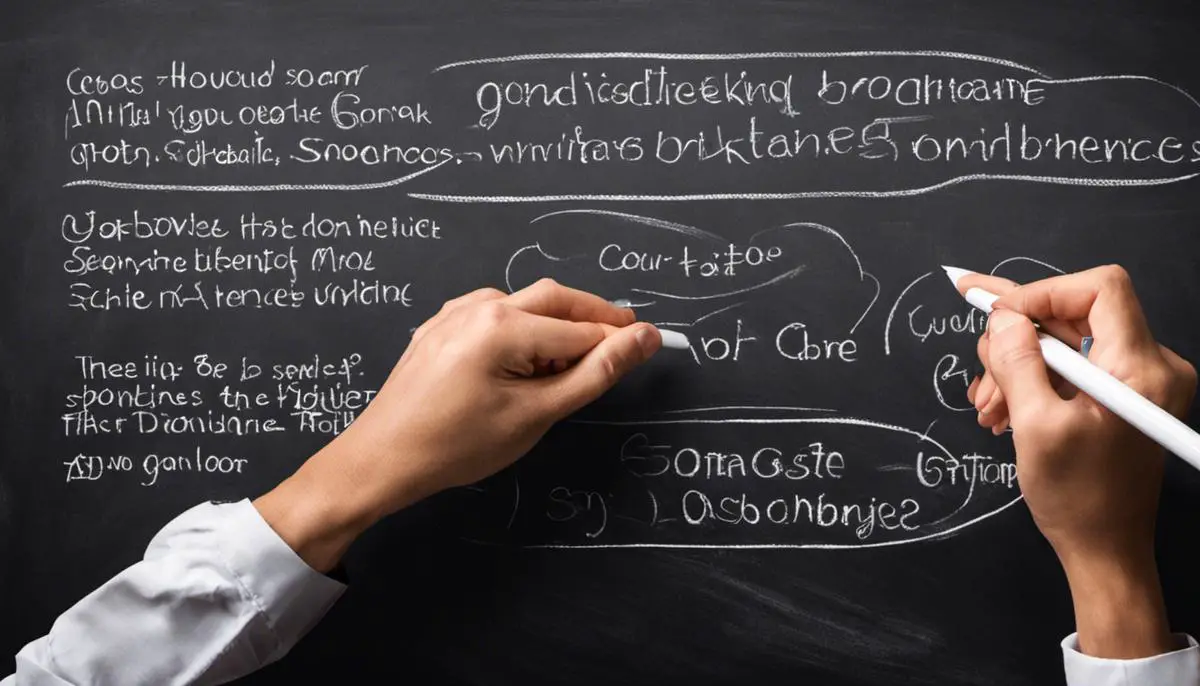Unearthing The Intricacies of Conditional Sentences
Conditional sentences, intrinsic to the English language, are studded with nuances that transform nuances of expression. An exploration of these multifaceted constructs enriches communication and offers insight into the complexities inherent to language itself. Each type of a conditional sentence allows for subtle deviation, carving a distinct path through the landscape of linguistic possibility.
In order to master the intriguing labyrinth of conditional sentences, we must delve into their distinguishing pillars: structure, usage, and the employment of auxiliary verbs. Equally important is the consideration of how time frames imbue conditional sentences with varying degrees of plausibility, along with the role of punctuations in modulating their tone and meaning. Indispensable to any compelling narrative, they serve as literary devices capable of painting vivid imageries of hypothetical scenarios.
Understanding Types of Conditional Sentences
A Comprehensive Analysis of Conditional Sentences: Function and Degrees of Certainty
Conditional sentences, a cornerstone of English syntax, divide into four categories, each delineating a distinct level of certainty taking into account theoretical possibility, likelihood and temporal context. In dissecting the varying types, this discourse will help elucidate their individual roles in communicating levels of certainty – a crucial premise for coherent communication.
Firstly, the Zero Conditional Sentence (Type 0), predominantly used to express general truths or scientific facts, propagates a high degree of certainty. The statement’s formulation hinges on a basic ‘if + present simple’ structure paired with a present simple result clause (e.g., ‘If water boils, it evaporates.’). This type establishes fundamental certainty because the outcome is always expected given the action or situation.
The Type 1 Conditional Sentence expresses a similarly high degree of certainty, but the sentences are temporally oriented towards real, likely events in the future. Using ‘if + present simple’ and ‘will + infinitive’, Type 1 allows for slightly less certainty on account of the future condition (e.g., ‘If you study hard, you will pass the exam.’). Here, passing the exam is highly likely but contingent on the realization of a specific future action – studying hard.
Moving on, the Type 2 Conditional Sentence structure, ‘if + past simple’ and ‘would + infinitive’, veers towards hypothetical, less likely situations. This type is inherently imbued with a lower level of certainty (Example: ‘If I won the lottery, I would buy a castle.’). While the situation is theoretically possible, it’s seen as unlikely, hence the diminished certainty.
The Type 3 Conditional Sentence offers the lowest level of certainty, as it outlines past conditions and their unrealized probable results. The sentence structure, ‘if + past perfect’ and ‘would have + past participle’, signifies unrealizable conditions as the time for the fulfillment of the condition has already passed (e.g., ‘If he had studied, he would have passed the exam.’). Here, the certainty of the result, passing the exam, does not exist, as the condition, studying, is an unrealized past action.
Finally, there exists the often-forgotten Mixed Conditional, incorporating elements of Type 2 and 3, delineating an unreal past condition and its probable present result. While technically plausible, the condition’s unfulfilled past nature substantially reduces certainty levels.
As discourse participants, it is essential to comprehend these structural distinctions in conditional sentences, as they perform pivotal roles in accurately portraying our intended level of certainty. Further studies into linguistic indicators like modal verbs and adverbials can provide an even deeper understanding, but the foundation of conditional sentences sets a robust stage for navigating English communication.

Conditional Sentences and Time Frames
The Temporal Influence on Constructing and Construing Conditional Sentences
As we find ourselves plunged deeper into the vat of linguistic nuance, the pivotal role of the time frame in constructing and interpreting conditional sentences becomes strikingly apparent. Where traditional constructs often remain congealed within labelled categories or ‘types’, the application and understanding of these linguistic tools extend to a milieu impacted by time parameters.
Initially, it’s vital to recognise that conditional sentences – dependent clauses predicated on specific circumstances or hypothetical situations – inherently possess a time-related dimension within their structure. They denote the consideration of an event or condition’s existence or nonexistence, either in the past, present, or future – each of which impacts the sentence form and consequent interpretation.
Further, conjugation of verbs performs critical temporal dance steps in this linguistic ballet. In tandem with the conditional clause (‘if’ clause), the verb’s tense in the main clause remarkably identifies the conditional sentence’s time frame. Let’s consider that in a scenario where the verb is in the present tense in the ‘if’ clause and the future tense in the main clause, the sentence implies a future happening dependent on a present condition.
Unpacking the intricacies of mixed conditionals provides a veritable example of the time frame’s influence. Here, the disconnect between the ‘if’ clause and the main clause’s verb tenses cater to the complex nuances of real-life circumstances. It allows the exploration of contrasting time frames – past conditions causing present effects or vice versa – expanding conditional sentences’ vistas into the realm of varied possible interpretations.
Moreover, when scrutinising conditional sentences in reported speech implementations, time frame adjustments (backshifting) become a highly necessitated adaptation. The employment of ‘would’ and ‘would have’ moulds the temporal framework to retain the original sentence’s desired implication while traipsing across different time zones of speech, underscoring another facet of influence exerted by time frame.
In conclusion, by highlighting the necessity of accurate verb tense pairing and the inevitable complexities that arise from the variation of temporal elements within the making of conditional sentences, one can discern the extent to which a time frame influences these constructions. Hence, a comprehensive understanding of the temporal intricacies involved in conditional sentences lays the groundwork for a profoundly nuanced interpretation and application of this versatile linguistic tool.

Punctuation Rules and Conditional Sentences
Diving deeper beyond the previously addressed topics, it is crucial to explore the role of punctuation in shaping the interpretation and semantics of conditional sentences. The placement of commas, full stops, and other punctuation marks might, at first glance, seem insignificant compared to the importance of verb tenses and time frames. Yet, these seemingly innocuous symbols wield considerable power over the comprehension and structure of conditional discussions.
Among the most frequently used punctuation marks in conditional sentences is the humble comma. Its placement can often delineate the ‘if’ clause from the main clause in conditional sentences. Indeed, it is the usage of commas that signifies the start and end of certain clauses and, ergo, directs the flow of conditional logic. For instance, in type 1 conditional sentences such as “If it rains, we will stay indoors,” the comma separates the ‘if’-clause from the resultant clause. Likewise, when the main clause precedes the ‘if’-clause as in “We will stay indoors if it rains,” the comma becomes extraneous, subtly altering the rhythm and flow of the sentence without altering its inherent meaning.
Punctuation also reinforces the mood of a conditional sentence. The utilisation of a full stop in expressing the finality of a situation is particularly apparent in zero conditional sentences which speak to universal truths. For instance, consider the sentence: “If you heat ice, it melts.” Here, the full stop punctuates the invariable truth of the condition. Additionally, it signifies the completion of the thought, making it an indissociable component of the sentence’s structure and meaning.
Contrastingly, the efficacy of punctuation in mixed conditional sentences is an enigma worth unraveling. A mixed conditional sentence amalgamates disparate time frames to express hypothetical or counterfactual scenarios. Misplaced commas in this scenario could not only obfuscate the intended meaning but also disrupt the temporal disconnect crucial to comprehending mixed conditionals. For instance, the sentence: “If you had taken the train, you wouldn’t be stuck in traffic now.” The comma here separates the two temporal spheres—the past (had taken the train) and the present (stuck in traffic)—thereby maintaining the integrity of the mixed conditional sentence.
In the realm of reported speech, it becomes pivotal to underscore the importance of punctuation. The inclusion, exclusion, or misplacement of commas might lead to misinterpretations, especially in the shifting time frames of conditional sentences.
To conclude, the essence of mastery over conditional sentences not only resides in an appreciation of tense and time frames, but also in the deliberate and artful use of punctuation. It is these minutiae that elevate the clarity, nuance, and precision of the language, thereby underlining the intrinsic beauty of complex linguistic structure.

Indeed, mastery of conditional sentences unlocks a new dimension of expression, enriching the palette of linguistic possibilities. Whether you’re relishing the highbrow vocabulary of a novel or sharpening your writing skills, these constructs help infuse your words with nuanced subtleties distinctive to hypotactical storytelling.
Beyond simply being constructs of grammar, conditional sentences are powerful tools in the hands of deft communicators, providing the ability to project a plethora of hypothetical situations. With an understanding of their various types and the inherent complexities, our linguistic capabilities are magnified, enabling us to explore diverse scenarios, infer meaning, and emote in multifarious contexts. Ultimately, mastering conditional sentences transcends linguistics, becoming a potent arsenal in the voyage of life, illuminating paths less travelled in the corridors of expression.
Discover Writio, the brilliant AI content writer crafting impeccable website posts. This article was written by Writio, your reliable pen-for-hire.
